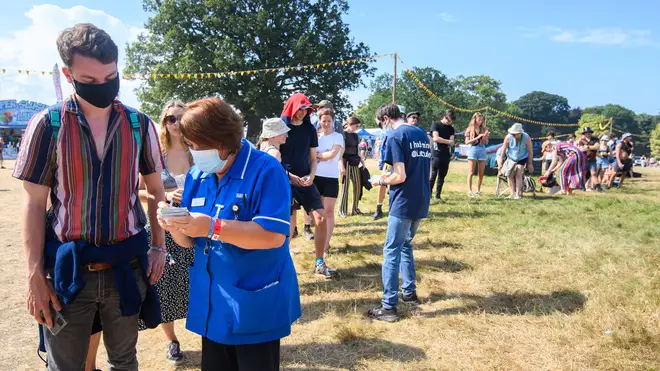
Oli Dugmore 4am - 7am
30 July 2021, 14:10 | Updated: 30 July 2021, 14:15

Covid infections are still rising across most of the UK but the latest ONS data shows "possible signs" the rate of infection in England could be slowing down.
Around one in 65 people in private households in England had Covid-19 in the week to July 24 - up from one in 75 in the previous week, according to the latest estimates from the Office for National Statistics (ONS).
Despite the rate increasing the ONS said there are "possible signs that the rate of increase may have slowed" as rates began to level off in most regions of England.
The ONS estimates that 856,200 people within the community population in England had COVID-19 in the week to July 24, 18,800 in Wales, 27,200 in Northern Ireland and 49,500 in Scotland.
The Welsh figure equates to around one in 160 people, up from one in 210 in the previous week, and the highest level since the week to February 12.
In Northern Ireland, the latest estimate is around one in 65 people, up from one in 170.
Latest data show #COVID19 infection rates have continued to increase in England, Wales and Northern Ireland and decreased in Scotland in the week ending 24 July 2021.
— Office for National Statistics (ONS) (@ONS) July 30, 2021
The Delta variant continues to be the most common in the UK https://t.co/HXYymKxo93 pic.twitter.com/0tUTs957aP
For Scotland, the ONS estimates that around one in 110 people had Covid-19 in the week to July 24, down from one in 80 in the previous week.
The number of Covid-19 infections in the UK, which is estimated every week by the ONS, is not the same as the number of new cases of coronavirus, which are reported every day by the Government.
The number of infections provides a snapshot of the prevalence of Covid-19 within the entire community population of the UK, and estimates the percentage of people who are likely to test positive for the virus at any one point in time - regardless of when they caught the virus, how long they have had it, and whether they have symptoms or not.
It is based on a sample of swab tests collected from households across the UK.
The ONS added that the Delta Variant is still the dominant strain in the UK.
The percentage of people testing positive for Covid-19 is estimated to have increased in all regions of England, apart from eastern England and south-west England where the trend is uncertain, the ONS said.

'The older ones are getting jabbed and the younger aren't interested.'
North-east England had the highest proportion of people of any region likely to test positive for coronavirus in the week to July 24: around one in 30.
North-west England had the second highest estimate: around one in 45.
Eastern England and south-west England had the lowest estimates: around one in 100.
Separately, the R number, the estimated average number of people each person with Covid goes on to infect, is now between 1.1. and 1.4 in England.
Last week it was between 1.2 and 1.4.
Boris Johnson pressed ahead with lifting remaining Covid-19 restrictions in England in spite of the prevalence of the Delta variant.
Despite the figures the Prime Minister was facing pressure today to allow double jabbed people to escape isolation sooner.
Labour leader Sir Keir Starmer challenged the Government to change the pandemic strategy for England after Wales to ensure fully vaccinated adults will not have to isolate from August 7.